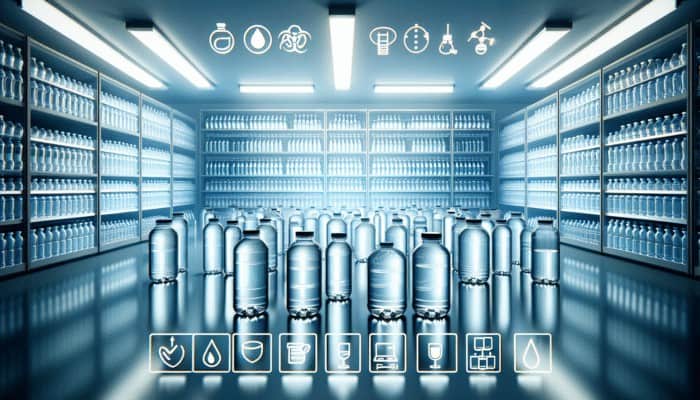Understanding the Vital Role of Emergency Water Reserves
The Critical Necessity of Water Reserves During Crises

Emergency Water Reserves: Water is fundamentally essential for life; however, during emergencies, the availability of clean water can diminish significantly. emergency water reserves serve as a crucial lifeline, ensuring that communities not only survive but also thrive when their usual water supplies are interrupted. Consider a city facing a catastrophic flood or an earthquake that severely damages existing water infrastructure. In these dire situations, having a stockpile of pre-stored water can be the decisive factor between life and death for thousands of individuals. It transcends mere thirst; it is about upholding health standards, preventing disease outbreaks, and fostering overall community resilience in the face of adversity.
When disaster strikes, the instinctive response is frequently to seek out potable water. In urban settings, water shortages can lead to panic, chaos, and even violence. Communities that have established Emergency water reserves can alleviate this chaos by ensuring immediate access to safe drinking water. Emergency reserves are particularly crucial in areas that are susceptible to natural disasters, but they have become a global necessity as climate change exacerbates extreme weather patterns. From the arid landscapes of sub-Saharan Africa to the flood-prone coastal regions of Southeast Asia, one universal truth remains: access to water is synonymous with survival.
The Multifaceted Benefits of Preparedness in Water Management
Preparedness is more than just a buzzword; it is a vital strategy for maintaining health and hygiene during emergencies. Picture a hurricane approaching a coastal town. Residents who take the initiative to stockpile emergency water reserves can significantly reduce their risk of dehydration and related health crises. When the taps run dry and emergency services are overwhelmed, those who have secured reserved water can maintain hygiene practices that are critical to preventing disease outbreaks.
The immediate advantages of preparedness extend beyond individual health. Communities that prioritise emergency water reserves can sustain high sanitation standards, thereby minimising the risks of outbreaks of diseases such as cholera or typhoid fever, which thrive in unsanitary conditions. The adage holds: an ounce of prevention is worth a pound of cure. Equipping communities with the essential tools needed to weather the storm can save countless lives while fostering a culture of resilience and responsibility that encompasses other critical resources as well.
Ensuring Long-Term Security and Stability Through Water Reserves
Long-term security is not merely a distant aspiration; it is an achievable reality for those who prioritise emergency water reserves. These reserves serve as a buffer against the unpredictable consequences of climate change, including droughts, floods, and other water-related crises. By investing in robust water storage systems and establishing reserves, communities can not only respond to immediate disasters but also lay the groundwork for long-term stability and resilience.
For example, cities that invest in comprehensive water management strategies often experience reduced economic losses during emergencies. Agriculture, a cornerstone of many economies, flourishes when farmers have access to water even during periods of drought. This creates a positive ripple effect, resulting in enhanced food security, economic stability, and social harmony. Preparing for potential water shortages is akin to preparing for a sustainable future, ensuring that communities are equipped to adapt to and thrive in the face of various challenges.
Implementing Effective Strategies for Water Storage

Storing water is not merely about filling tanks; it is both a science and an art. Effective strategies for emergency water reserves must encompass methods that guarantee safety and accessibility. First and foremost, it is crucial to select the appropriate storage containers. Food-grade plastic or glass is an optimal choice, as they prevent the leaching of harmful chemicals into the water. Moreover, conducting regular inspections and adhering to guidelines for disinfection can help keep stored water free from contaminants.
Innovative storage solutions are emerging globally. From underground cisterns designed to capture rainwater in arid regions to advanced filtration systems that render surface water safe for consumption, the possibilities are limitless. In countries like India, community-led initiatives are actively harvesting rainwater, creating sustainable solutions that replenish groundwater aquifers. As we delve into these strategies, it becomes evident that effective water storage is not just about preparation; it is about harnessing our collective ingenuity to ensure safety and accessibility for all.
The Collaborative Roles of Communities and Governments in Water Management
Collaboration is the foundation of sustaining emergency water reserves. It is insufficient for individuals to act in isolation; both community members and government agencies must work in unison to establish effective systems. Governments have a crucial role in formulating policies that support water reserve initiatives, funding infrastructure, and encouraging active community participation. When government entities collaborate with local organisations, the outcomes can be transformative.
Consider successful models from around the world, such as the community-led water management systems in Sweden. Here, local stakeholders play active roles in the monitoring and maintenance of water reserves, fostering a sense of ownership and responsibility. Conversely, in regions where government support is lacking, communities often struggle to develop effective reserves. The lesson is clear: collaboration not only amplifies resources but also enhances trust and resilience within communities during times of crisis.
Exploring the Various Types of Emergency Water Reserves
The Essential Role of Surface Water Storage
Surface water reserves, including lakes, reservoirs, and ponds, are vital lifelines for communities in need of emergency water supplies. When natural disasters disrupt normal water supply channels, these bodies of water can become lifelines, provided they are treated appropriately before consumption. For instance, in the heart of the Amazon rainforest, indigenous communities rely on large rivers as sources of drinking water after thorough purification, demonstrating how nature can serve as a reservoir during critical moments.
Effectively utilising surface water hinges on proper treatment. Technologies such as UV purification and advanced filtration systems can ensure that stored surface water is safe for drinking. In urban environments, some cities have turned to stormwater management systems that capture and treat rainwater runoff, transforming a potential hazard into a valuable resource. The global push for sustainability urges us to think innovatively about how we can harness available resources, essentially redefining our relationship with water.
Harnessing the Power of Groundwater Reserves
Groundwater is a hidden treasure, often overlooked yet essential for providing a reliable source of water during emergencies. Accessed through wells and boreholes, these reserves can offer a crucial supply when surface water sources are compromised. Countries such as Ethiopia and India have long depended on groundwater for agricultural and domestic use, illustrating its importance in our daily lives.
However, tapping into this resource necessitates careful management. Overextraction can lead to depletion, resulting in long-term water scarcity. Innovative practices, such as rainwater harvesting and recharge wells, can aid in replenishing groundwater supplies, ensuring that these reserves remain viable for future emergencies. With the right approach, communities worldwide can harness the power of groundwater to support sustainability and security.
The Role of Bottled Water Stockpiles in Emergency Preparedness
The simplicity and convenience of bottled water stockpiles make them a critical component of emergency water reserves on a global scale. Pre-packaged and ready for immediate use, bottled water serves as an ideal solution for rapid distribution to affected populations during emergencies. In the wake of hurricanes or earthquakes, bottled water often becomes a highly sought-after commodity, frequently being one of the first supplies delivered to disaster-affected areas.
Nonetheless, while bottled water provides immediate relief, it also raises significant concerns about sustainability. The environmental impact of plastic waste cannot be ignored. Communities must strike a balance between the benefits of bottled water and the imperative to reduce plastic consumption. Exploring alternatives, such as refillable water stations during non-emergency periods, can help mitigate this issue. Innovative solutions, such as biodegradable packaging or large-scale water purification stations, can also ensure that bottled water remains a viable option without burdening the environment.
Strategic Planning and Implementation for Water Reserves
Assessing Community Water Needs for Effective Reserves
Understanding the water requirements of a community is paramount for establishing effective emergency water reserves. It involves more than merely counting heads; it requires calculating daily consumption needs and anticipating increased demand during crises. For example, the average individual in a temperate climate typically requires two to four liters of water daily for hydration. Still, this figure can double or even triple in high-stress situations or hotter climates.
Effective assessments necessitate collaboration with public health officials, community leaders, and disaster preparedness agencies to determine what “normal” looks like for each community. For instance, communities in drought-prone areas may need more substantial reserves than those in regions with consistent rainfall. By evaluating historical data, water usage patterns, and potential future scenarios (such as population growth or climate change), communities can craft a customised water reserve plan tailored to their unique needs.
Crafting a Comprehensive Water Reserve Plan
Creating a thorough water reserve plan is akin to designing a blueprint for community resilience. It involves pinpointing potential water sources, determining optimal storage locations, and devising effective distribution methods to ensure efficient use. A well-thought-out strategy might integrate diverse sources—from surface water to groundwater and bottled supplies—ensuring that no single resource is relied upon exclusively.
Engaging stakeholders throughout the planning process is crucial. Local governments, emergency services, community organisations, and residents should have a voice in shaping the plan. This collaborative input fosters a sense of ownership and responsibility for the initiative’s success. Additionally, detailed contingency plans for various scenarios must be developed, ensuring that when disaster strikes, response protocols are clear, efficient, and equitable.
Fostering Community Involvement and Educational Outreach
The successful implementation of emergency water reserves hinges on active community involvement and education. When individuals understand the significance of water reserves, they are more likely to engage in planning and preparedness activities. Workshops, community meetings, and educational campaigns can raise awareness about the importance of water conservation and the vital role of emergency management.
Programs that actively involve community members in practical actions—such as constructing rainwater harvesting systems or coordinating bulk water storage initiatives—cultivate a sense of unity and purpose. In countries like Kenya, grassroots movements focused on water education have empowered communities to take ownership of their local water resources, significantly enhancing disaster preparedness. By fostering a culture of awareness and involvement, communities can ensure that their water reserve systems are not only established but also resilient and effective.
Ongoing Maintenance and Management of Water Reserves
Conducting Regular Inspections and Water Quality Testing
The adage “An ounce of prevention is worth a pound of cure” holds for aining emergency water reserves. Regular inspections and water quality testing are essential to ensure that reserves remain safe and usable during crises. Communities need to establish a routine inspection schedule that evaluates both the physical storage facilities and the quality of the water itself.
Testing for contaminants such as bacteria, nitrates, or harmful chemicals should occur at least annually. In areas vulnerable to flooding, more frequent tests may be necessary to address potential contamination quickly. Local health departments or environmental agencies can provide resources and support for these testing initiatives. By prioritizing regular maintenance and testing, communities can protect themselves against the potential dangers of relying on contaminated water during emergencies.
The Importance of Preventive Maintenance
Preventive maintenance is the unsung hero of effective emergency water reserves. It is significantly more cost-effective to maintain water storage facilities and equipment proactively than to deal with the consequences of contamination or system failures. Simple measures, such as ensuring proper sealing of water storage tanks, can thwart the intrusion of pollutants and debris.
Training volunteers or local officials on maintenance protocols can foster a culture of responsibility within the community. Scheduled maintenance activities—such as cleaning storage tanks, checking filtration systems, or repairing leaks—should be documented to ensure accountability. Cultivating a culture of preventive maintenance instills confidence; when the time comes for communities to rely on their reserves, they can do so with a sense of peace of mind.
Implementing Effective Inventory Management Practices
Maintaining an efficient inventory management system for emergency water reserves is crucial to ensuring that supplies are always ready for use. This involves keeping an accurate count of bottled water stockpiles, monitoring expiration dates, and employing a first-in, first-out (FIFO) method to minimize waste. Regularly updating inventory records also helps identify shortages and plan for replenishments.
Communities can leverage technology to streamline inventory management. Simple tracking software or mobile applications can automate notifications for restocking and testing schedules, making them more efficient. In larger urban areas, collaborating with local businesses to secure support and resources can help bolster inventory levels and enhance operational efficiency. By prioritising effective inventory management, communities improve their readiness for emergencies and ensure that resources are available when needed most.
Optimising Distribution and Access to Water Reserves
Establishing Efficient Distribution Systems
When disaster strikes, every second counts, and having efficient distribution systems for emergency water reserves is essential. Delays in delivering water to affected areas can exacerbate suffering and complicate recovery efforts. Communities must devise and implement distribution plans that facilitate rapid delivery to those in need, particularly in densely populated or remote areas.
Utilising a combination of local volunteers and established delivery networks can optimise distribution efforts. For example, partnerships with local businesses or non-profits can help mobilise resources swiftly. In urban settings, pre-determined distribution points can streamline access, ensuring that water reaches those who require it without unnecessary delays. Efficiency in distribution not only saves lives but also reinforces public confidence in emergency response systems.
Ensuring Equitable Access to Water Resources
Equitable access to emergency water reserves is fundamentally a matter of justice. Disparities in access often become pronounced during emergencies, with vulnerable populations facing the most significant challenges. To ensure that all community members receive the support they need, planners must prioritise equity in their distribution strategies, guaranteeing that everyone, regardless of socioeconomic status, can access essential resources during crises.
Collaborating with community organisations that understand the unique needs of marginalized groups can enhance equitable access. Regular engagement with these communities can lead to tailored solutions, such as mobile distribution units that reach isolated areas or specific outreach programs that address language barriers. In the aftermath of disasters, equitable access to water can be a lifeline for those who are often overlooked, underscoring the importance of inclusivity in crisis response.
Setting Up Emergency Water Stations for Community Access
Establishing emergency water stations in strategic locations can provide accessible points for water distribution during crises. These stations serve as hubs where communities can gather essential drinking water, minimising the need for individuals to travel long distances when resources are scarce. Effective placement of these stations—including community centres, schools, or places of worship—ensures that individuals can access water with relative ease.
Communities should consider deploying portable water stations that can be quickly set up in the aftermath of an emergency. These systems can be established in response to specific needs and relocated as situations evolve. Training volunteers to manage these stations promotes community engagement while ensuring that water distribution runs smoothly and efficiently. Emergency water stations can fundamentally change the way communities respond to crises, prioritising access to clean water for everyone involved.
Implementing Monitoring and Reporting Systems for Transparency
To guarantee the effectiveness and transparency of water distribution and access during emergencies, communities must implement robust monitoring and reporting systems. This involves collecting data on water usage, distribution patterns, and community feedback to refine operations continually. Technology plays a pivotal role here; mobile applications or online platforms can facilitate real-time tracking of water supplies and distribution.
Involving residents in monitoring efforts fosters a sense of accountability and community ownership. Regular reports can be shared with the public, demonstrating transparency in the distribution process and building trust within the community. By prioritising monitoring and reporting, communities can adapt and respond to changing conditions, ensuring that their emergency water reserves remain effective and accessible for all.
Identifying Challenges and Developing Solutions
Navigating Limited Resources and Funding for Water Initiatives
Limited resources and funding can significantly obstruct the establishment and maintenance of emergency water reserves. Often, communities find themselves competing for funding against other pressing needs, creating a challenging catch-22 situation. However, by seeking grants, forming partnerships with local businesses, and engaging in community fundraising efforts, they can effectively overcome these barriers.
Innovative financing models can also help alleviate resource constraints. For instance, social impact bonds serve as a mechanism to attract private investment in public projects by tying returns to performance metrics. Furthermore, employing technology to optimise resource management can lower costs and enhance efficiency. By thinking creatively about funding and resource allocation, communities can establish robust water reserve systems even in the face of limitations.
Overcoming Infrastructure and Logistics Challenges
Infrastructure and logistics challenges can be formidable when establishing emergency water reserves. To tackle these issues, communities must conduct thorough infrastructure assessments to identify gaps and weaknesses. This may involve evaluating existing water distribution networks, storage facilities, and transportation mechanisms to ensure they can adequately support emergency response efforts.
Planning for transportation logistics is also critical. In remote areas, all-terrain vehicles or drones can facilitate water delivery to hard-to-reach locations. Additionally, collaborative efforts with local governments and disaster response organisations can streamline logistics management, ensuring a coordinated response. By proactively addressing infrastructure challenges, communities can enhance their preparedness and resilience when disasters strike.
Enhancing Public Awareness and Support for Water Reserve Initiatives
Increasing public awareness and garnering community support are essential for the successful implementation of emergency water reserve programs. Without public buy-in, initiatives can flounder, leaving communities underprepared. Campaigns that highlight the critical importance of water conservation, storage, and emergency preparedness can galvanise community members to take proactive measures.
Engaging influencers and local leaders can amplify these messages, creating a ripple effect throughout the community. Educational initiatives, such as workshops and outreach programs, can empower residents to contribute actively. By prioritising public awareness and fostering community support, communities cultivate a culture of preparedness, ensuring that when emergencies arise, they are not just ready—they are resilient.
Embracing Technological Innovations in Water Management
Revolutionising Water Purification Technologies
Innovative water purification technologies are transforming our approach to emergency water reserves. In regions where clean water is scarce, portable purification systems can swiftly convert contaminated water into safe drinking water. Technologies such as solar purifiers or advanced filtration units provide sustainable solutions that are both accessible and effective.
For example, in disaster-affected areas, the rapid deployment of mobile purification units can offer immediate relief, ensuring that communities have access to clean water when they need it most. Additionally, emerging technologies, such as graphene-based filters, promise breakthroughs in water treatment, potentially enhancing purification processes on a global scale. By embracing these innovations, communities can strengthen their emergency water reserves and improve their overall resilience in the face of crises.
Frequently Asked Questions about Emergency Water Reserves
What exactly are emergency water reserves?
Emergency water reserves refer to stored supplies of clean water that are specifically designated for use during disasters or emergencies when regular sources become unavailable.
Why are emergency water reserves crucial for communities?
They guarantee access to safe drinking water during crises, help prevent dehydration, and maintain sanitation standards, ultimately saving lives in critical situations.
How can communities effectively prepare for potential water shortages?
Communities can prepare by assessing their specific water needs, developing comprehensive reserve plans, and actively involving residents in education and preparedness initiatives.
What are the different types of water reserves available?
Types include surface water storage (such as lakes and reservoirs), groundwater reserves (like wells and boreholes), and bottled water stockpiles that provide immediate access.
What actions can I take to contribute to local water reserve initiatives?
You can engage by volunteering for community water programmes, advocating for funding and resources, and promoting sustainable water conservation practices within your community.
What are the benefits of community involvement in establishing water reserves?
Community involvement fosters a sense of ownership, accountability, and effective response during emergencies, significantly enhancing overall resilience and preparedness.
How frequently should water quality be tested in reserve systems?
Water quality should be tested at least annually, but more frequent testing is advisable in areas at risk of contamination due to flooding or other disasters.
In what ways can technology assist with the management of emergency water reserves?
Technology can aid in purifying water, optimising distribution systems, and monitoring supplies, ensuring effective management and accessibility during emergencies.
What strategies ensure equitable access to water distribution?
Equitable access strategies include collaborating with local organisations, ensuring distribution points are accessible to all community members, and tailoring approaches to meet the needs of marginalised groups.
What role do governments play in the establishment of water reserve systems?
Governments support these initiatives through the creation of policies, funding, and the establishment of partnerships with local communities to build and maintain effective water reserve systems.
Join us on our journey on X!
Survival Radio Options: Essential Gear for Emergencies
Comprehensive Guide to Different Types of Survival Radios Portable Handheld Radios for Emergency Situations Survival Radio Options: Portable handheld radios are essential components of any effective survival strategy, providing unparalleled portability and user-friendliness during emergencies. These devices are specifically engineered to be lightweight, making them perfect for activities like hiking, camping, or preparing for unforeseen […]
Emergency Radio Picks: Your Universal Survival Guide
Comprehensive Guide to Emergency Radio Picks: Stay Informed During Crises What Are Emergency Radio Picks and Their Significance? Emergency Radio Picks: These devices are meticulously engineered to receive important broadcasts during crises, ensuring that individuals remain updated when standard communication channels fail. These radios are indispensable tools that provide vital information about weather emergencies, natural disasters, […]
Surviving a City Blackout: Essential Tips
Essential Steps for Blackout Preparedness Gathering Crucial Emergency Supplies Surviving a City Blackout: Being proactive in your preparation for a blackout is absolutely vital. Remember that power outages can occur unexpectedly and may last for several days, impacting your daily life significantly. It is prudent to ensure you have enough essential supplies to manage this […]
Grid-Down Heating: Essential Strategies
Exploring Effective Strategies for Heating During Power Outages What Is Grid-Down Heating and How Does It Work? Grid-Down Heating: Grid-down heating encompasses a range of innovative and traditional heating solutions that are employed when the electrical grid is incapacitated due to power outages. In these circumstances, reliance on conventional heating systems becomes impractical, prompting the need […]







Your reflections on emergency water reserves resonate deeply with me. I remember volunteering in a community hit by devastating floods a few years back, and it was shocking to witness how quickly access to clean water became a critical issue. People often overlook that it’s not just about staying hydrated; the ripple effects on health, sanitation, and even mental well-being are profound during such crises.
It’s wild how quickly our world can turn into a game of survival, right? You hit the nail on the head about those hidden consequences — water isn’t just about quenching thirst; it’s like the unsung hero of good health and sanity. You realize that when people are racing for clean water, it’s like watching a real-life version of musical chairs, but the music’s been replaced with the sounds of anxiety.
I’m glad to hear your thoughts on this important issue! If you’re interested in exploring ways to support communities facing similar challenges, check out this resource for more information on building sustainable water reserves.
https://survivalbite.com/LostFoods